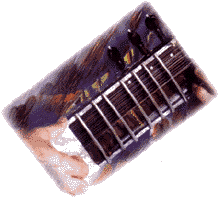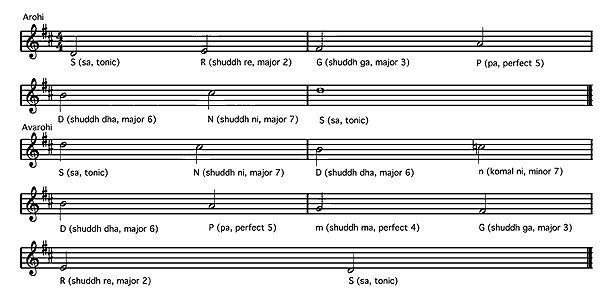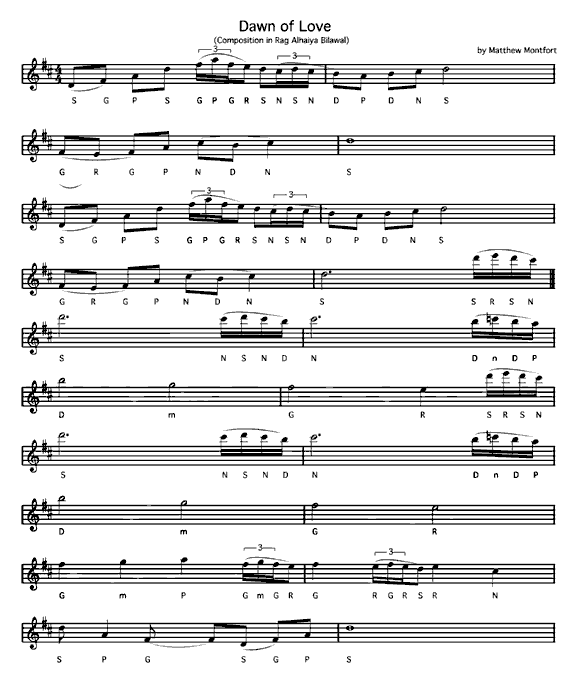North Indian Raga

Learn more through online lessons with Matthew Montfort.
45 minute lesson - $48:
Zoom Lessons Make Excellent Gifts!
A raga is a melodic recipe for a mood. In Hindustani (North Indian) classical music, each raga has certain moods associated with it, and usually has a specific time of day and/or season in which it is meant to be played. Raga could be described as a "super scale" using a set of notes in ascending (arohi) and descending (avarohi) order, sometimes including prescribed alternate or zig zag routes (vakra chal), a hierarchy of note importance including king notes (vadi) and prime minister notes (samvadi) a fourth or fifth apart, and a key phrase that shows the heart of the movement of the raga (pakar).
This ancient system is both an art and a science of how musical notes create certain moods. Western music also recognizes that note order and hierarchy create a mood, with some theory texts noting that songs in major keys tend to communicate happiness while songs in minor keys show a feeling of sadness. But the rags show precisely how to create a specific mood. The recipe for each raga holds the key to an unlimited number of potential melodies, each perpetuating the mood or rasa contained in the raga, but each a unique work of art.
Study of this system can be of great benefit to any composer or improvising musician.
Sargam
Indian raga uses a system of solfeggio called sargam. There are seven note names per octave, just as in the Western "do re mi fa so la ti do" system, starting with sa, the tonic note that is also the main drone note. Indian music does not utilize the concept of "perfect pitch" where absolute note values are recognized. Sa can be set to any note, and is normally set to the most convenient place for the instrumentalist or vocalist. For example, a sitar is normally tuned with sa at a Western equivalent near C# or D because that is the most practical place for that instrument. The other notes are then found in relationship to sa.
Sargam: Sa Re Ga Ma Pa Dha Ni Sa Scale degree: 1 2 3 4 5 6 7 8 If sa is D: D E F# G A B C# D
Just as in Western music, there are 12 main tones per octave, but there are also microtonal ornaments similar to the use of quarter tones in the blues. Indian raga uses a non-tempered tuning system where Sa and Pa are tuned a perfect just fifth apart. The other notes are close to the Western just tuning system, but the tuning of individual notes can vary from raga to raga.
The note name system is much less confusing than the interval system in use in Western music. Each scale degree needs only one name because ragas do not change key. The word komal is used for the minor or flat version of a note, shuddh means natural or major, and tivra corresponds to sharp or augmented. Sa (1) and pa (5) cannot be modified. Re (2), ga (3) dha (6) and ni (7) can be either shuddh (normal or natural, corresponding to the Western major intervals) or komal (flat, corresponding to the Western minor intervals). Ma (4) can only be shuddh (the natural perfect 4th) or tivra (corresponding to the Western augmented fourth).
The main 12 tones are notated in sargam as follows:
S r R g G m M
sa komal re shuddh re komal ga shuddh ga shuddh ma tivra ma
perfect 1 minor 2 major 2 minor 3 major 3 perfect 4 augmented 4
.
P d D n N S
pa komal dha shuddh dha komal ni shuddh ni sa
perfect 5 minor 6 major 6 minor 7 major 7 perfect 8A dot is added above a note to indicate an octave higher, and a dot is added below a note to indicate an octave lower. The modifying words "shuddh, komal, and tivra" are not sung as part of the sargam system, but are used in instruction for clarification purposes. One learns to know whether a note is shuddh, komal, or tivra by how it sounds. Learning the sargam system is a great aid to developing excellent relative pitch skills.
Structural Form in Hindustani Classical Music
The full traditional unfolding form of raga development in Hindustani classical music begins with an alap (the first section in which the notes of the raga are introduced and explored without rhythmic accompaniment) followed by jor (second section included in or succeeding the alap, in rhythm, but without fixed meter) and jhala (the last section played with rapid strokes in a fast rhythm before the tabla enters). After this, a slow gat (fixed instrumental composition following the alap, jor and jhala, that signals the tabla player to join the performance) is introduced, followed by a fast gat and jhala (this time with tabla accompaniment).
Rag Alhaiya Bilawal
Alhaiya Bilawal is the most commonly known raga of the Bilawal group of ragas, which are based on the same intervals found in the major scale. Bilawal is portrayed in ragamala paintings as a lady waiting in anticipation for her lover to arrive.
Elements of Rag Alhaiya Bilawal
Time: late morning (9 am-noon)
Moods: sringar (joy and love), karuna (pathos, compassion, sadness)
Vadi (king note): Dha (major 6)
Samvadi (prime minister note): Ga (major 3)
Vadi-Samvadi (King and Prime Minister Notes)
Pakar (Heart Phrase)
Arohi-Avarohi (Ascending and Descending Scales)
Ma, the perfect fourth, is normally omitted in ascent except for when it is used in an oblique manner. Komal ni, the minor seventh, is only used in descent in an oblique manner, as shown in the avarohi for the raga, where it appears sandwiched between two major sixths (dha).
Asthai and Antara
The asthai is the primary theme in Hindustani music, similar to the refrain in Western music, and is usually performed in the middle register. The antara is the second, higher part of a composition, showing the upper register.
Dawn of Love
Ancient Future leader Matthew Montfort wrote this composition showing asthai and antara late one morning after practicing Rag Alhaiya Bilawal as taught by Ali Akbar Khan. This composition stays fairly close to the raga (even using the heart phrase intact), but yet exploits the natural tendencies of the guitar. It is an example of how ragas contain compositions just waiting to be discovered.
Guitar-Sitar Jugalbandi Performance of Dawn of Love
Ancient Future performing Guitar-Sitar Jugalbandi version of "Dawn of Love"
(Subscribe to A.F.A.R. to download audio)
Jugalbandi is a classical North Indian musical duet (literally "tied together"), in this case with the unusual configuration of sitar and guitar accompanied by tabla. This performance of "Dawn of Love" was rendered by the Guitar-Sitar Jugalbandi variation of Ancient Future featuring Pandit Habib Khan on sitar, Matthew Montfort on scalloped fretboard guitar, and Arshad Syed on tabla. It is available in The Archive of Future Ancient Recordings by Ancient Future.
The compositional form used in this contemporary world fusion performance as closely resembles that of a jazz standard as it does that of Hindustani classical music, so it is not surprizing that in this performance Pandit Habib Khan was moved to briefly explore a blues scale during his solo (from 6:02 to 6:33). Rather than employing the long development structure of Hindustani classical music, there is a short introduction without tabla accompaniment (a loosely defined alap) by each melodic instrument followed by the main melody and solos with tabla accompaniment.
Further Resources
Indian Tala
To learn more about the rhythmic side of Indian music, check out these online exercises in Indian tala.





